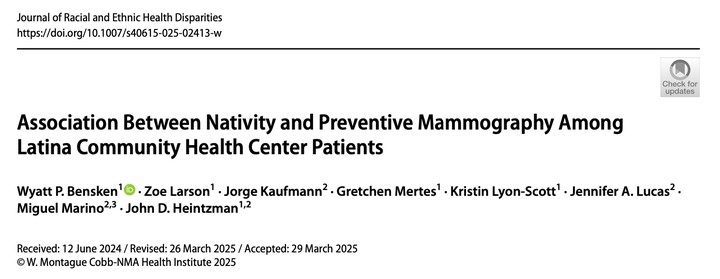Association Between Nativity and Preventive Mammography Among Latina Community Health Center Patients

Abstract
Background: In the United States, Latina women have delayed mammography utilization, yet it is unknown how use varies among patients who receive primary care from community health centers who serve a disproportionately high number of Latina patients. Methods: We used data (2013–2022) from a nationwide network of primary care organizations. The main outcome of interest, mammography among females over the age of 50, was analyzed in two different ways: (1) being up to date on mammography and (2) time to first mammogram after age 50. We used covariate-adjusted generalized estimating equations logistic regression and Cox proportional hazard models to estimate the association between nativity (US-born versus Foreign-born, region of origin, and country of origin) and mammography. Results: Among the 24,579 included patients, being up to date with mammography varied by nativity, with US-born Latinas having 1.55 (95% CI: 1.27, 1.90) and Foreign-born Latinas having 1.85 (95% CI: 1.64, 2.10) times the odds of being up to date compared to Non-Hispanic White (NHW) females. Foreign-born Latinas, regardless of region or country of origin, had a higher prevalence of being up to date compared to US-born NHW and US-born Latinas. Latinas from the Caribbean and Central America had the highest prevalence of being up to date, with those from South America having the lowest. Finally, US-born Latinas and Foreign-born Latinas had a shorter time to first mammography. Conclusion: US-born and Foreign-born Latinas had greater mammography use than NHW patients highlighting the important role of community health centers in preventive cancer care for Latinas.